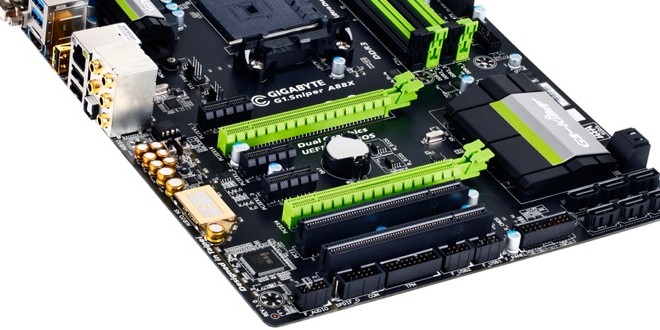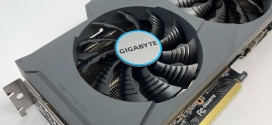SATA III Performance
Read
| Sequential | 512 | 4K | 4KQ32 | |
| Gigabyte G1.Sniper A88X | 426.6 | 330.2 | 22.74 | 240.6 |
| Gigabyte Z77 | 435.3 | 29.6 | 29.33 | 347.3 |
Write
| Sequential | 512 | 4K | 4KQ32 | |
| Gigabyte G1.Sniper A88X | 445.0 | 417.8 | 89.46 | 233 |
| Gigabyte Z77 | 470.4 | 465.5 | 84.14 | 333.7 |
We had an issue with the AMD board with the OCZ Vertex 3 Max IOPS SSD where we noticed the 4K random read and write performance is significantly slower on AMD than on the Intel board. The performance difference is not minor but rather 3 times slower on the AMD platform. While we have seen AMD platform to perform slower than the Intel, it is often not that big of a difference.
So, we swapped out the Vertex 3 Max IOPS with a Vertex 4 and noticed the performance difference between the AMD and Intel platform is much narrower than we had observed. Still, the latest AMD A88X chipset continues to be a tad slower than the Intel’s offering. The 4K random read on the A88X is about 20% slower but the 4K random write is actually faster by 6% on the AMD platform. Higher queue depth definitely favors the Intel system. The sequential read and write on the A88X is also a tad slower but only by 2% for read and 5% write. Random read is where users probably will notice the biggest performance when loading applications so you may notice apps launch a hair slower on AMD system. However, unless you have both system side-by-side to compare, we doubt any one would be able to notice the difference as any system with an SSD would probably load apps almost instantaneously.
Power Consumption
At idle, the G1.Sniper A88X with the AMD A10-6800K CPU and the integrated GPU consumes 33 watts of power and under load with x264 second pass, we noticed the system consumes 120 watts of power. When we push the system with Prime95, we noticed the system reached 144 watts of power. If we add Furmark with Prime 95, we noticed the system consumes 156 watts of power.
Conclusion

Granted, compare to other G1.Sniper boards from Gigabyte, the A88X version is definitely missing some features. But we have to consider the pricing point of the FM2+ platform so it would not make much sense for Gigabyte to produce a board that carries a premium with all of the high-end features found on other board unless the company is going to put the board’s retail price at close to $200. At retail price of the $115, the G1.Sniper A88X is competitive in pricing against other FM2+ boards while packing with some neat features that enhances the gaming experience. The most noticeable feature that the board has is obviously the audio enhancement with inter-changeable OP-AMP, Gain Boost, and the USB DAC up. All things considered, the board is certainly worth considering if you are in the market for an inexpensive FM2+ gaming PC.
| Pros | Cons |
|
|
Review Overview
Performance - 8
Value - 8.5
Quality - 9
Features - 8.5
Innovation - 9
8.6
Gigabyte G1.Sniper A88X
Gigabyte G1.Sniper A88X is designed with gamers in mind with the enhanced audio and network performance. The add-on features is welcomed for AMD mainstream FM2+ (Kaveri) platform for any gamer who is looking to build a relatively budget gaming rig.
 Bjorn3D.com Bjorn3d.com – Satisfying Your Daily Tech Cravings Since 1996
Bjorn3D.com Bjorn3d.com – Satisfying Your Daily Tech Cravings Since 1996







